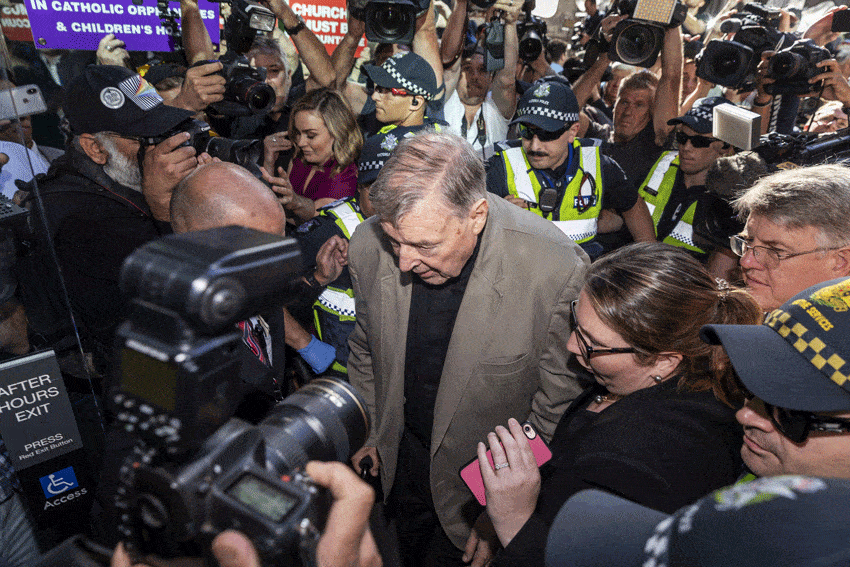
A case that should never have happened
It’s time to declare that George Pell is innocent of the preposterous charges he faced in the County Court of Victoria and to move on for the good of everyone, including bona fide complainants and victims of child sexual abuse in institutions.
Because of the suppression orders put in place by the County Court, you were unable to follow the trials of Cardinal George Pell day by day. That’s why I was asked to attend the proceedings. That’s why I have published a book, Observations on the Pell Proceedings – so you can make your own assessment of the evidence.
My book is dedicated ‘to those who seek truth, justice and healing and to those who have been denied them’. Having followed the Pell proceedings closely, I am convinced that the case did nothing to help bona fide complainants, victims, and their supporters.
I write in the introduction: “The failures of the Victoria police, prosecution authorities, and the two most senior Victorian judges in these proceedings did nothing to help the efforts being made to address the trauma of institutional child sexual abuse. As a society we need to do better, and the legal system needs to play its part.”
I am convinced that light and healing can be more readily sought and hoped for if appropriate steps are taken to correct the errors made in the Pell proceedings. The compounding errors resulted in the unanimous judgment of the High Court of Australia which placed the Victorian criminal justice system in a very poor light.
I was left in no doubt. Cardinal Pell was innocent of these charges. He should never have even been charged.
I am convinced that light and healing can be more readily sought and hoped for if appropriate steps are taken to correct the errors made in the Pell proceedings.
At the first trial, the jury could not agree. So a second trial was held at which Pell was convicted of all five charges. The Victorian Court of Appeal upheld the convictions by 2-1.
The dissenting judge was Mark Weinberg, the most experienced criminal appeal court judge in the country. He has now completely retired from the bench having taken up the demanding task of Special Investigator into the Afghanistan war crime allegations. The High Court sat all seven judges on the final appeal. They were unanimous in their judgment signing on to just one statement of reasons ordering that Pell’s “convictions be quashed and judgments of acquittal be entered in their place.”
At trial, the defence called no evidence. The prosecution’s main witness was the complainant ‘J’ (his name was and remains suppressed) who described what he said he recalled having happened to him and his friend, the now deceased ‘R’, in 1996 when they were 13 years of age. But the prosecution also called, at the request of the defence, a lot of other witnesses who were involved with the solemn masses celebrated in St Patrick’s Cathedral Melbourne in late 1996 – sacristan, MC, choristers, choir master and organist.
Given that it was alleged that four of the five offences were said to have occurred in the priests’ sacristy shortly after mass when usually you expect to find altar servers in attendance, it was surprising that the police did not interview any altar servers and the prosecution was not minded to call any altar servers until the defence forced their hand.
By the time of the second trial, two altar servers recommended for inclusion by the defence were called by the prosecution to give evidence. One of these altar servers, Jeff Connor, had a comprehensive diary which allowed the prosecution to identify the only possible dates for the offences to have occurred: 15 and 22 December 1996.
The other altar server, Daniel McGlone who is now a barrister, provided evidence of his attendance at one of these masses where he and his mother met Archbishop Pell on the steps after mass.
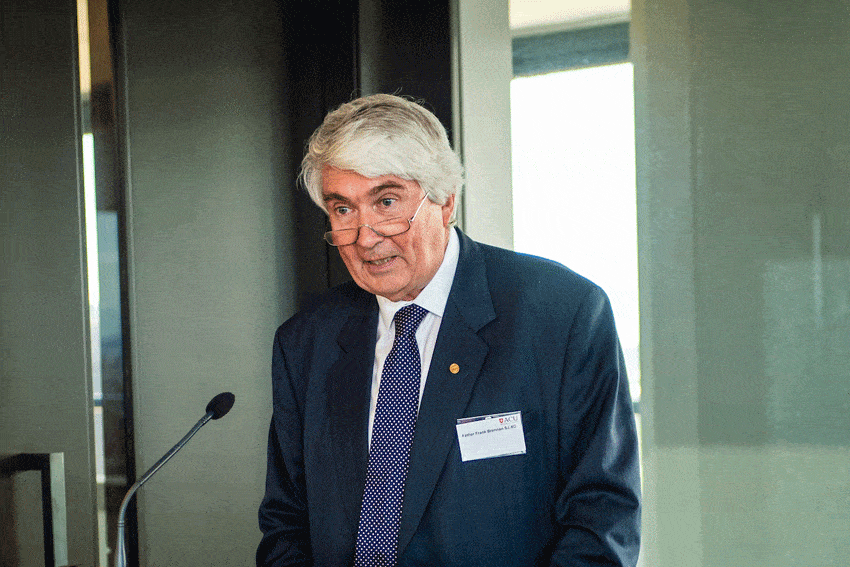
The High Court noted: “The trial judge held that evidence adduced by the prosecution that was inconsistent with, or likely to contradict, J’s account of events, was relevantly “unfavourable”. His Honour granted leave to the prosecutor to cross-examine a number of witnesses (and foreshadowed the grant of leave in relation to other witnesses)” with respect to six topics.
Despite having obtained the leave to cross-examine, the prosecution never took up that option and so never challenged the version of events given by the opportunity witnesses.
The six topics included: ‘(i) whether (Pell) was always in the company of another, including (the MC) Portelli or (the sacristan) Potter, when robed; (ii) whether (Pell) always greeted congregants on the steps of the Cathedral following Sunday solemn Mass’.
The High Court noted that this grant of leave to cross-examine ‘reflected the trial judge’s satisfaction that the anticipated evidence, if accepted, excluded the realistic possibility of the offending having occurred as J described it.’
The High Court noted, “The honesty of the opportunity witnesses was not in question.”
In its conclusion, the High Court realising that the crown case was full of holes decided to focus on just a few essentials. The court saw no need to address all the improbabilities or impossibilities raised by the defence.
The court said: ‘The likelihood of two choirboys in their gowns being able to slip away from the procession without detection; of finding altar wine in an unlocked cupboard; and of the applicant being able to manoeuvre his vestments to expose his penis are considerations that may be put to one side.” There was no need to consider the possibility or likelihood of these matters.
Having reviewed all the evidence and having accepted for the purposes of argument that “the Court of Appeal majority did not err in holding that J’s evidence of the first incident did not contain discrepancies, or display inadequacies, of such a character as to require the jury to have entertained a doubt as to guilt” the Court went on to conclude:
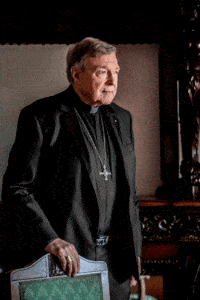
“It remains that the evidence of witnesses, whose honesty was not in question, (i) placed (Pell) on the steps of the Cathedral for at least ten minutes after Mass on 15 and 22 December 1996; (ii) placed him in the company of Portelli when he returned to the priests’ sacristy to remove his vestments; and (iii) described continuous traffic into and out of the priests’ sacristy for ten to 15 minutes after the altar servers completed their bows to the crucifix.”
So that was it – game, set and match.
On the evidence led in the case, there was no way that Pell and the two boys could have been alone together in the priests’ sacristy soon after mass. There was neither time nor place for the offences to be committed. Absent both time and place in any narrative and you are in the realm of fantasy or false memory. The most basic police work would have disclosed this early in an investigation, particularly in a properly run investigation which had the huge resources committed as the Victoria Police dedicated to Operation Tethering which had Pell as its sole focus.
When the complainant J first presented to police on 18 June 2015, he had a fairly simple account of how he, his friend R and Cardinal Pell came to be in the priests’ sacristy at St Patrick’s Cathedral on their own while Pell did dreadful things to them.
They were finishing mass, and as usual, they were in an internal procession going directly from the sanctuary to the choir room via a corridor which passed the priests’ sacristy which they had never previously entered. They would have taken only 56 steps to get there. The two boys started ferreting around going to places they should not go, and they discovered some altar wine in the priests’ sacristy and started swilling it.
Mind you, even this account was problematic. Where were all the other people who would be passing along that corridor at that time, and especially, where were the people who would have been coming and going from the priests’ sacristy immediately after mass, ferrying things from the sanctuary, bringing in money for collection or counting, concelebrants changing out of their garb etc?
J stated that he never revisited the priests’ sacristy until the police took him on a walk through preparing for the case.
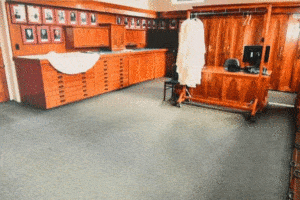
If the journalist Louise Milligan were accurate in her reporting and if R’s mother was rightly recalling her own conversation with J, J also had another account at that time.
Let me quote Milligan’s account directly which purports to be a record of the conversation between Milligan and the mother “sometime after the detectives took her statement” on 1 July 2015, which was after J had provided his first statement to police on 18 June 2015 (but before he made his second statement on 31 July 2015) alleging that the offending had occurred after mass:
“(J) gently told her what he says happened with the Archbishop. “He told me that himself and [my son] used to play in the back of the Church in the closed-off rooms,” she says.
“In the cathedral?” I ask her.
“In the cathedral, yep. And um, they got sprung by Archbishop Pell and he locked the door and he made them perform oral sex.” (J) still remembered the incident so clearly. Being picked up afterwards by his parents. Staring out the car window on the way home.”
In the second edition of her book Cardinal, Milligan changed the detail about a locked door to a blocked door, and omitted all reference to J being picked up by his parents. The effect of these changes was to bring her account more into line with the evidence J gave at trial. Milligan doesn’t explain whether the other boy’s mother just got these things wrong or whether Milligan got them wrong. But it doesn’t much matter.
This second account of recurring ferreting in back rooms when no one else was around was dropped altogether, or more accurately never adopted by the prosecution.
Milligan didn’t give it much more of a run. It became generally known that Pell did not live at the cathedral presbytery and was only ever there for major liturgical events.
The first account of a one-off escapade straight after mass received a considerable re-working.
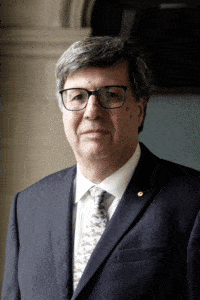
You will recall that Shane Patton (who when appointed Victorian Police Commissioner in June 2020 was described as ‘forthright and analytical’, with his colleagues saying he was ‘right into the detail’ ) led a couple of his men to Rome to interview Cardinal Pell on 19 October 2016. At the interview, Detective Sergeant Chris Reed was accompanied by Detective Inspector Paul Sheridan.
Preparing for the record of interview, Pell had thought, in light of the preliminary written details given him by the police, that the allegations related to assaults in a back room of the cathedral some time after choir practice when others would not be around – much like the Milligan account which was published a year later.
But it was now made clear to him that the allegation was that the assaults occurred soon after solemn 11am mass in the priests’ sacristy. Having heard that, Pell must have thought that the police would realise that J’s allegations were unreliable, if not ridiculous.
At the outset in the interview Pell told the police: “The allegations relating to Saint Patrick’s cathedral are … the products of fantasy.” He went on to say:
“The most rudimentary interview of staff and those who were choir boys at the cathedral in that year and later would confirm that the allegations are fundamentally improbable and most certainly false and I invite my interviewers to tell me who they’ve spoken to and I’m happy to provide them in due course the persons who can speak authoritatively about my functions, presence and conduct at the cathedral generally and more particularly at times when abuse is alleged to have occurred.”
“I would earnestly hope that this is done before any decision is made whether to lay charges because immeasurable damage will be done to me and to the church by the mere laying of charges which on proper examination will later be found to be untrue. Thank you.”
Detective Sergeant Chris Reed responded, “Thank you. I appreciate that.”
Mr Reed, Mr Patton, and Detective Superintendent Sheridan returned to Australia and did nothing of the sort. Pell gave the police four vital pieces of information of which they were previously unaware, and which should have brought the investigation to an end after some very simple police work back home.
Four vital pieces of information from the Pell record of interview, 19 October 2016
1.The Hive of Activity in the Priests’ Sacristy After Mass
The first vital piece of information was that there would be a hive of activity in the priests’ sacristy after mass, including the sacristan, his assistant, money collectors, concelebrants and altar servers.
Pell told the police that they should go back to Melbourne and interview these people who would be able to corroborate his claim that it was just not possible for Pell to be alone in that place at that time with two choir boys. Here are Pell’s actual words spoken at the record of interview:
“Now, the sacristy after mass is generally a hive of activity because you’ve … well have got the sacristan there and often you had an assistant sacristan. If there were concelebrants, they would divest. The servers would get out of their vestments. The collectors would bring in the collection. The sacristan and the assistants would be bringing the chalice and the vessels out from the altar. Now, I was always accompanied by my master of ceremonies after the mass, so he would come around with me and help me unrobe. It was just the protocol.”
When J’s version was put to him, Pell said, “What a load of absolute and disgraceful rubbish. Completely false. Madness. All sorts of people used to come to the sacristy to speak to the priest. The sacristans were around, and altar servers were around. This is the sacristy at the cathedral after Sunday Mass?”
Mr Reed replied, “yes’” To which Pell responded, “Well, need I say anymore. What a load of garbage and falsehood and deranged falsehood. My master of ceremonies will be able to say that he was always with me after the ceremonies until we went back to the car park or back to the presbytery. The sacristan was around. The altar servers were around. People were coming and going.”
The police led by Mr Patton with an eye for detail returned to Melbourne and did not interview one single money collector nor one single altar server.
By the time of the second trial, the police had been provided with the diary of an altar server Jeff Connor who documented key participants at each mass. Here is Robert Richter’s cross examination of Christopher Reed the lead investigator at trial:
Yes. One of the interesting things about his diary is you were able to establish, from his diary, the names of a whole lot of altar servers, who were relevant to the relevant period?
– Well, relevant period. There was altar servers – I don’t – I actually don’t recall reading the – a name of altar servers in the diary of Mr Connor.
Well, in the diary entries he has lunch, they have regular lunches?
– Okay.
Do you recall reading something like that, and he names them? For example, in July, ‘Serves luncheon at Jimmy Watson’s Lygon Street, Carlton, with Ray, Ralph’ and a few other names there that I can’t read?
– I don’t recall that entry, no.
All right. They had regular lunches, get togethers, the altar servers, the adults?
– Okay.
You accept that, don’t you?
– Yes, I’ll accept that, yes.
So what happens is this; apart from the fact that we tracked down Mr Connor you had not tracked down any altar servers at all?
– No, that’s correct.
But the altar servers were a very, very important part of this investigation?
– Well, not during the investigative stage, no, we were concerned with the choir boys specifically, because the events that have been alleged occurred surrounding the choir boys, not the altar servers that were in a different location and had a different role.
But there weren’t any choir boys present when this happened, alleged to have happened?
– Well, there weren’t any altar servers.
There weren’t any of those present … ?
– There weren’t any altar servers alleged to be present either.
Correct, but the altar servers took part in processions in the same way that the choir boys took part in the processions?
– That’s correct, yes.
And not just that, the altar boys were more important because the altar boys were in a position to say what they did after mass in the priest sacristy?
– Evidence has been given to that effect, yes.
Yes, and you accept that?
– I accept the evidence that’s given, yeah.
So the situation is that apart from Jeff Connor – it was certainly possible to ask him for the names of other altar servers who were operational at the time?
– Yes, it was.
But he was never asked by anyone in the taskforce?
– No, he wasn’t.
No attempt was made by the police on their return from Rome to contact any altar server, or any money collector, or any concelebrant.
Why?
Because J said none of them was in attendance. Pell had told them that these people would routinely have been in attendance in the very spot and at the very time that the offending was alleged to have occurred. Instead of investigating the allegations, the police simply accepted J’s account unquestioningly including the assertion that there were no altar servers present during any of the periods that the first incident could have occurred.
They interviewed no altar servers. But they interviewed over 30 choristers.
Why?
Because J was a chorister. Choristers don’t enter the priests’ sacristy after mass, unless of course they are misbehaving.
This policing technique, if applied to other cases, would compromise many a criminal investigation. Let’s consider an example where police receive a report of a crime, not from a victim but from someone who is simply an honest eyewitness. Imagine if a pedestrian claimed to witness a bank robbery, telling the police that she did not see any bank tellers in attendance when the bank vault was raided.
The police then spend 18 months interviewing 30 other pedestrians, but they decide not to interview any bank tellers because the pedestrian witness said she did not see any. The police would want to interview all available bank tellers if only to learn from them what their usual practices were, assisting the police to understand how the robbery could possibly have happened.
The necessity of interviewing the bank tellers as part of a proper investigation is underscored if there is evidence that routinely bank tellers would be in attendance at the time the robbery occurred.
2.The Procession Route
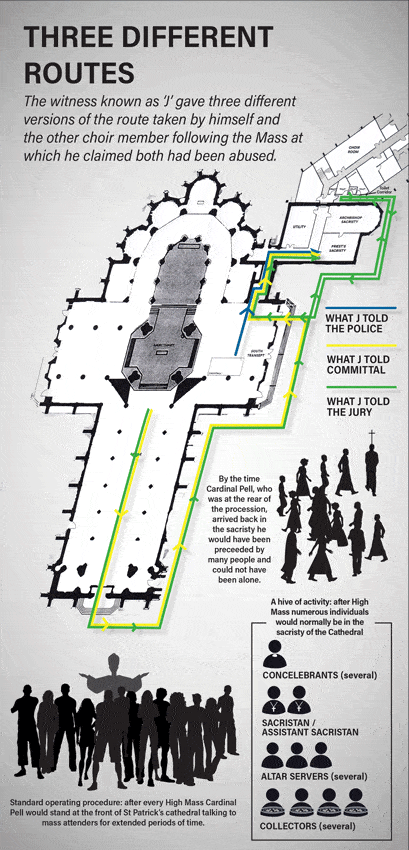 During the record of interview, Pell told the police that it was usual after a solemn mass in the cathedral celebrated by the archbishop that the whole entourage including the choir of up to 60 members would not recess simply by way of an internal procession of 56 steps from the sanctuary direct to the sacristy.
During the record of interview, Pell told the police that it was usual after a solemn mass in the cathedral celebrated by the archbishop that the whole entourage including the choir of up to 60 members would not recess simply by way of an internal procession of 56 steps from the sanctuary direct to the sacristy.
Rather with the full fanfare of a recessional hymn followed by an Organ Voluntary, they would all process down the central nave exiting at the west door, then engaging in an external procession around the south side of the cathedral. I’ve measured that route at 308 steps. Together with the cathedral MC I have walked the route at procession speed. It takes about four and a half minutes. I should note that being over 6’ 4”, my steps tend to be more than average.
Pell told the police to go back to Melbourne and speak to the relevant people. When they got back to Melbourne the police found that cathedral personnel like the MC Monsignor Charles Portelli, the choirmaster Mr John Mallinson, the organist Dr Geoff Cox, and the sacristan Mr Max Potter confirmed what Pell had said about external processions.
If the weather were inclement or if Pell had another appointment shortly after mass, they would do an internal procession. But otherwise they would process externally. There would be lots of tourists around. It was obviously something of a spectacle. J seemed to be on his own, claiming that internal processions were routine and the order of the day.
By the time of the committal proceedings in March 2018, J’s evidence was that on the day of the first four offences there had indeed been an external procession, and not an internal procession as he had earlier claimed in his police statements of 18 June 2015 and 31 July 2015 and in his later walk-through with the police on 29 March 2016 at the cathedral.
Victorian Supreme Court Justices Chief Justice Ferguson and President Maxwell wrote in their judgment: “In the 2016 walk-through, J said that the choir would come up and down the internal sacristy corridor every Sunday, before and after Mass.”
For some unexplained reason, J remained fixed on the idea that he and R gained access to the priests’ sacristy via the corridor they would have used if it had still been an internal procession. He described a two step route. First there was an external procession.
Second, when he and R got close to the south transept, the two of them without any prior planning and without any discussion peeled off from the procession, entering the cathedral via one of the doors at the south transept, then following the corridor which they would have taken if it were an internal procession. I have measured that route. It is 277 steps.
By the time Pell came to his first trial in the County Court in August 2018, J was confronted with a mountain of evidence from other witnesses called by the prosecution who claimed that it would be very difficult for two young boy sopranos at the front of the procession to peel off from the procession while it was still in train outside the cathedral, and to do so without being seen by others including adult choir members who would have been in line behind them with a clear line of sight.
Later, J’s evidence became that he and R had remained in the procession until it reached the toilet corridor hidden from the view of the tourists. The toilet corridor is a narrow passageway outside the cathedral that provides access to public toilets and to the sacristies via a locked door.
J and another chorister Andrew La Greca (on whom Louise Milligan was very reliant ) gave evidence that by the time the procession reached the toilet corridor, order was breaking down and people were starting to disperse. So while inside the toilet corridor which is just 1.33m wide, J and R spontaneously and without any prior planning or discussion decided to go against the flow, finding their way out of the toilet corridor, back to the south transept then resuming the route which they would have taken to the priests’ sacristy if indeed it had been an internal procession.
He insisted that they walked; they did not run. I have measured this new convoluted route at 408 steps. It takes five and a half minutes.
By the time of the second trial, the prosecution, searching to find the six minutes during which the offending was said to have occurred, had postulated that the offending must have occurred during the private prayer time after mass.
This six minutes was said to be the time that the sacristan Max Potter allowed for congregants to pray uninterrupted after mass before he got his altar servers to start their clearing duties on the sanctuary.
This six minutes had to elapse before the altar servers leading the procession had reached the priests’ sacristy when they bowed to the crucifix at the end of their procession, and before they commenced their duties ferrying sacred items from the sanctuary to the priests’ sacristy.
So here was the problem. J claimed that he and R were ferreting around and “would have only been in the room for a couple of minutes maximum before Pell came in.”
But on the final version put the jury, they had already spent at least five and a half minutes on the convoluted new route getting to the sacristy in the first place. Mind you, it would have taken them longer than that because J said they were poking around various places before they got to the priests’ sacristy.
You’d wonder what the two boys would have discussed with each other before they started their poking around and as they backtracked the 122 steps from the toilet corridor to the south transept and into the priests’ sacristy.
Back in Rome, the change of the procession route was the matter which most concerned Detective Superintendent Sheridan. It was the only matter on which he took over from Detective Sergeant Reed during the interview seeking clarification that indeed the usual practice when the weather was fine was for Pell to process down the centre aisle and then to process externally after having stopped for a considerable period of time greeting parishioners on the cathedral steps at the West Door.
Sheridan realised that there were problems with J’s account of the internal procession.
As it turned out, there were to be even greater problems with an amended account of an external procession that swallowed up all the available time for the offending to have occurred.
One can only speculate whether Detective Superintendent Sheridan was thereafter unhesitatingly prepared to run with J’s account after these warning lights started flashing.
The final route proposed by J not only swallowed up all the possible time for the sacristan Potter to wait before instructing his minions to commence ferrying items from the sanctuary. It created all sorts of imponderables.
How would two 13 year-old boys with no previous planning decide to head off on such a convoluted route? Why wouldn’t they have simply continued to the end of the toilet corridor turning left and commencing their ferreting, taking just 22 steps down the corridor which was all so familiar to them, given that they went up and back along that corridor every Sunday as J had told the police during the walk-through in March 2016?
What made them think they would not have been sprung upon entering a sacristy which was decidedly off-limits to the choir?
For most if not all of the six minutes during which Potter was allowing time for people to say their prayers after mass, J and his companion were not walking directly to the priests’ sacristy via the 56 step internal procession, they were on a convoluted outside procession and cutback of 408 steps which would have taken them at least five and a half minutes before you factor in the additional couple of minutes for ferreting around, finding the wine and swigging it.
3. Greeting on the Steps
Pell also told the police at the record of interview that his practice was to greet congregants on the steps at the west door after mass.
In his record of interview, Pell said, “I mean let me – let me start to roll out – most things on these or this story is counter factual and with a bit of luck I’ll be able to demonstrate point by point. The first thing is that after every mass I would stay out at the front of the cathedral and talk to people.”
The prosecution willingly conceded that this protocol might have developed later in Pell’s ministry but they questioned whether Pell would have spent very long on the steps after his first two solemn masses as archbishop at 11am on the Sunday.
Anyone with experience of these things knows that the new archbishop once he stopped on the steps to greet people would have been besieged by his new parishioners.
At his first couple of masses, he would have been more likely to spend more time rather than less greeting those keen to meet their new pastor. If in any doubt about Pell’s style and practice at this time, just consider the two page feature done on Pell in the Melbourne Age the month before these critical masses.
Karen Kissane ended her 4,000 word article The Gospel According to George describing Pell after a funeral mass at Fawkner parish:
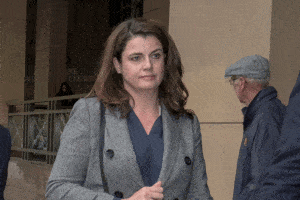
“After the service they spill on to the concrete outside and the older Italians line up in front of Pell to pay their respects. They reach for his hand, then bend and kiss his knuckles or his ring in an ancient gesture of homage. Some wipe away tears. Pell is unsurprised and responds to each one with a few words or a blessing. Later, when he tries to pose for a photograph, he is surrounded by a flock of giggling nonnas half his size who want to get in the picture too.
They are quite unembarrassed; he is their archbishop, the face of their church, and he belongs to them. This is Catholic faith in the old style, ritualised, tribalised and unquestioning.” Every minute Pell spent on those steps after the 11am mass further blew out of the water the prosecution theory that Pell could have been back in the sacristy within six minutes of leaving the sanctuary.
Even if he’d proceeded directly from the sanctuary without stopping to greet a single parishioner, he would have needed to take 308 steps over a four and a half minute period which would have commenced after everyone else had processed before him, including 60 members of the choir and a handful of altar servers.
You will appreciate that the person at the rear of a procession of at least 70 people processing in twos arrives at the final destination some time after those at the head of the procession. Neither Pell nor J would have made it to the sacristy within the private prayer time, even if that time ran for six minutes rather than two minutes at most as Mallinson had testified.
One day when visiting the cathedral taking measurements, I was told by the MC that the archbishop leaves the sacristy at 10.54am precisely, when celebrating the 11am mass.
So it usually takes the archbishop and his entourage up to six minutes to process at the beginning of mass from the sacristy to the west door of the cathedral. The procession of choristers, servers, concelebrants and archbishop would take the same time to return.
4. Accompanied by MC Portelli
Pell also told the police at the record of interview in Rome that he would have been accompanied at all relevant times by his MC Monsignor Portelli. The prosecution investigated a couple of strategies to separate Pell and Portelli for the critical 6 minutes needed for the offending to occur.
The first strategy took up Portelli’s admission that if there was another commitment for the archbishop in the cathedral that afternoon, Portelli might have taken a couple of minutes to reorder the archbishop’s speaking notes and liturgical books back at the lectern on the sanctuary. But there were no such scheduled events on these days. It was suggested that the archbishop might have celebrated the evening mass at the cathedral and that might have required Portelli to prepare papers at the lectern.
There was no evidence of that.
When the archbishop celebrates the main solemn mass in the cathedral on a Sunday he does not return to celebrate the low-key evening mass. In any event such an absence would account only for a couple of minutes absence.
A second strategy was attempted unsuccessfully at both trials. The prosecution suggested that Portelli might have ducked out for a smoke while being fully vested himself and while the archbishop was still in procession at the end of mass or while the archbishop was on the steps greeting parishioners.
Both times, the prosecutor had to retract the suggestion before the jury and apologise. Not only was there no evidence to support the suggestion, the only evidence excluded all possibility of the suggestion. The suggestion was put directly to Portelli by the prosecutor and he denied it. For example at the second trial, the prosecutor asked Portelli:
You said you were a 20 cigarettes a day man, mass has been for over an hour, you didn’t go outside to have a smoke after mass?
– It would be as appropriate as for instance His Honour walking down William Street dressed as he is smoking a cigarette, which is not done.
When the prosecutor put the suggestion to the jury a second time, this was the indication as to just how difficult it was for the prosecution to find those magical 6 minutes when Pell could be alone together with the two boys in the sacristy.
Conclusion
I’ve said enough to indicate why no one can seriously question the conclusion of the seven High Court judges. Let me quote to you again their conclusion:
“It remains that the evidence of witnesses, whose honesty was not in question, (i) placed (Pell) on the steps of the Cathedral for at least ten minutes after Mass on 15 and 22 December 1996; (ii) placed him in the company of Portelli when he returned to the priests’ sacristy to remove his vestments; and (iii) described continuous traffic into and out of the priests’ sacristy for ten to 15 minutes after the altar servers completed their bows to the crucifix.’”
Chief Justice Ferguson and Justice Maxwell denied the validity of this conclusion. By way of contrast, here is what they concluded:
“In our view, taking the evidence as a whole, it was open to the jury to find that the assaults took place in the 5-6 minutes of private prayer time and that this was before the ‘hive of activity’ described by the other witnesses began. The jury were not bound to have a reasonable doubt.”
The High Court rightly concluded that on the overwhelming weight of evidence neither Pell nor the two boys could have been in the sacristy during those six minutes. The boys were processing and back-tracking and ferreting; Pell was processing down the main aisle and out on the steps greeting his new parishioners.
The High Court rightly concluded that on the overwhelming weight of evidence neither Pell nor the two boys could have been in the sacristy during those six minutes.
Upon the analysis of the High Court and consistent with the painstaking review of the totality of the evidence by the dissenting Justice Weinberg in the Victorian Court of Appeal, there was not the evidence to convict Pell on any of these charges.
Since the High Court decision, no one has come up with even a credible theory as to how Pell and two choir boys could be alone together completely uninterrupted for six minutes in the priests’ sacristy soon after mass and before choir rehearsals for the Christmas concert.
If the police had their doubts about the statements of Pell, Portelli and Potter, on their return from Rome in October 2016 they should have sought out and spoken to any altar servers, money collectors and concelebrants who would have been there, before instituting committal proceedings 18 months later.
In the Rome interview, Pell had provided the police with an inconvenient truth: J’s account was just not credible. But, undaunted by this inconvenient truth, the police returned to Melbourne and pursued their unsustainable case theory.
None of us knows the identity of the complainant, nor should we. When the High Court acquitted Cardinal Pell of all charges, J issued a statement through his lawyer Vivian Waller saying:
“My journey has been long and I am relieved that it is over. I have my ups and downs. The darkness is never far away. Despite the stress of the legal process and public controversy I have tried hard to keep myself together. I am OK. I hope that everyone who has followed this case is OK.”
Earlier, Vivian Waller told Louise Milligan: “My client’s had a very long journey. The criminal process has been quite stressful for him and it’s not over yet. Like many survivors, my client has experienced depression, loneliness struggle with various issues over time.”
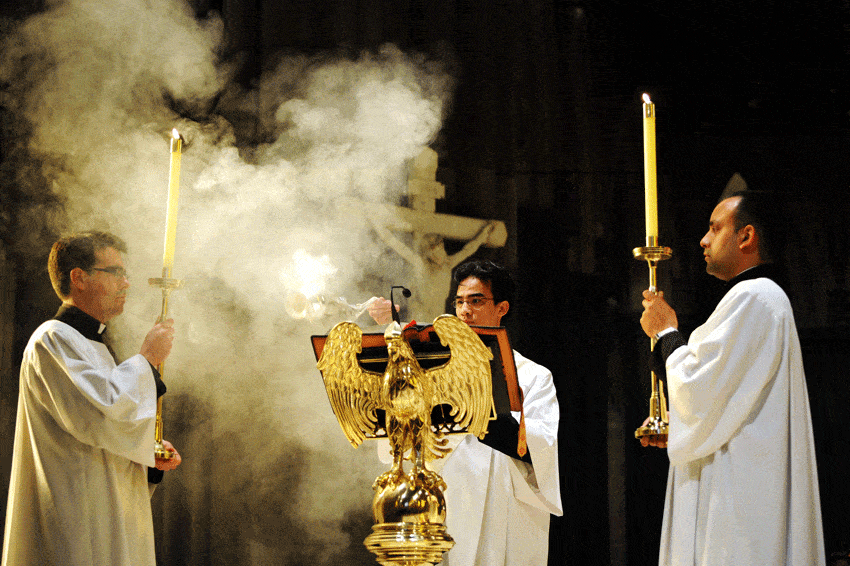
Undoubtedly he has suffered additional trauma through the processes of the law, including the appeals all the way to the High Court. Much of it was avoidable. These processes have also re-traumatised many other people who have experienced institutional child sexual abuse and who have placed hope in our legal system. Their situation would have been assisted if the police in this case had undertaken competent policing.
These failures in due process exposed J to needless and avoidable harm and imposed the grossest injustice on Cardinal Pell.
From the moment VicPol laid charges, the reality was that Pell had to prove his innocence to the public. VicPol knew that the mere laying of these charges against Pell would devastate, if not destroy his reputation, in the community. In part, VicPol therefore bears the responsibility for the appalling scenes of vitriol and abuse outside the County Court after Pell’s conviction became known.
Everything said by the High Court and by Justice Weinberg vindicates the claims made by Pell in his record of interview, particularly his claims about an external procession, his greeting parishioners on the steps, his being accompanied by his MC, and the sacristy being a hive of activity.
If only the police had subjected J’s recollections and claims to closer scrutiny after learning these recollections of Pell about his usual practice at the cathedral. If only they’d interviewed some of the altar servers. If only they had tracked down and interviewed some of the money collectors and concelebrants. With competent policing, there would have been no need for these trials and appeals.
If only the DPP had insisted that the police provide a brief of evidence capable of countering not only Pell’s account, but also the claims made by a string of opportunity witnesses who honestly recalled to the best of their ability what went on at the cathedral during the busiest time of the week.
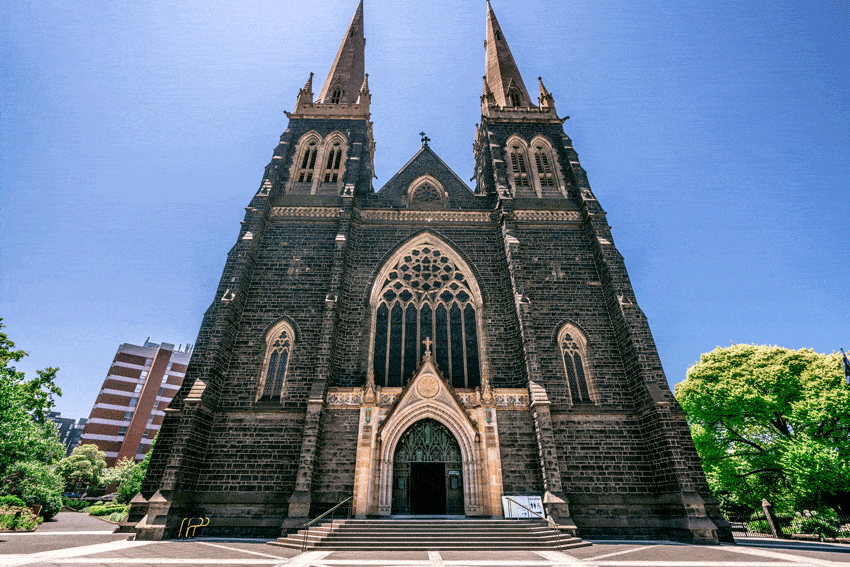
The DPP has a policy that it ‘not put forward theories that are not supported by evidence’ . By the time the case got to the High Court, the DPP appearing in person did put forward theories not supported by the evidence.
Kerri Judd QC asserted wrongly that the altar servers adjourned to the ‘worker sacristy’ for the critical minutes, and that the private prayer time might have been much more than six minutes. There was no evidence for either proposition.
She even submitted that the matter should be remitted to the Victorian Court of Appeal because the High Court did not “have before it the material to enable it to determine whether the verdicts are unreasonable or cannot be supported by the evidence.”
In its judgment, the High Court described this submission with one word: “specious.”
The Pell saga reminds us that we should be grateful that we live in a federation with the High Court of Australia overseeing the criminal justice systems of the states and territories.
It was specious to suggest that the Pell matter be referred back to the Victorian criminal justice system.
When Cardinal Pell walked free from prison, he said, “I hold no ill will toward my accuser, I do not want my acquittal to add to the hurt and bitterness so many feel; there is certainly hurt and bitterness enough. The only basis for long term healing is truth and the only basis for justice is truth, because justice means truth for all.”
I hope my book and these remarks contribute to justice, truth and healing.
Father Frank Brennan SJ is the Rector of Newman College at Parkville in Melbourne and an adjunct professor of law at the Thomas More Law School at Australian Catholic University.
Listen to The Catholic Weekly’s interview with Fr Frank Brennan:
Related:
